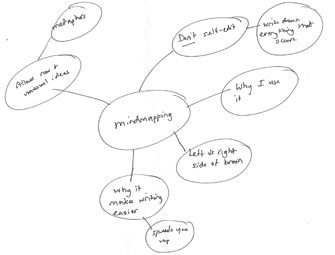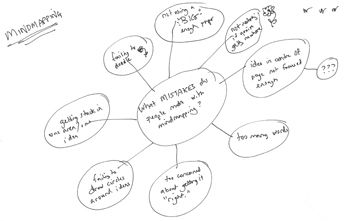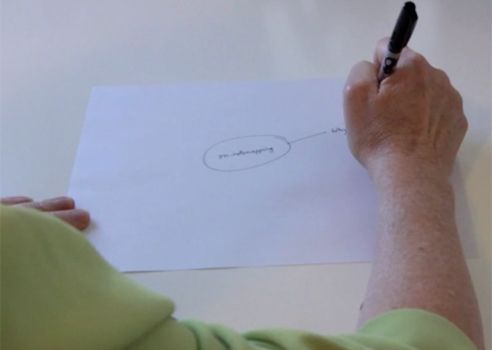Reading time: About 4 minutes
Video: Just under 7 minutes
Have you ever struggled with mindmapping? Here is a video, and a post, designed to teach you how to create a mindmap…
Like a cardiologist who see nothing but hearts with problems — and therefore finds them easier to diagnose — I see a lot of broken mind maps. Clients send them to me asking for help. “What’s gone wrong?” they ask. “How can I fix it?” Some of them even say, flatly, “mindmapping just doesn’t work for me.”
I’ve been mindmapping long enough I can now say that the process should work for almost everyone. If it doesn’t work for you, you may fall into the less-than-one-percent camp of people who are the exceptions that prove the rule.
More likely? You just need some help. Recently, clients have started asking for a video of me doing a mindmap. Much as I hate seeing my own face on the screen (ICK!) I finally agreed to do it. Besides, much of the video (you can see it on my blog) is shot over my shoulder….
The first part of the video shows me following most of the rules related to mindmapping. I’ve turned my piece of paper sideways. I’ve written my topic in the centre of the page. And I’ve allowed a bunch of secondary ideas to radiate outwards. (My handwriting is so horrible, I’m going to list the ideas for you here, even though you can also see a picture of the mindmap, adjacent.)
Going clockwise from top right:
- Don’t self-edit.
- write down everything that occurs to you
- Why I use it.
- Left vs. right side of brain
- Why it makes writing easier.
- Allows you to develop/find new/unusual ideas
- metaphors
The objective of a mindmap is not to provide an outline of everything you’re going to write. Its purpose is to inspire you…to make you feel like writing. And this particular mindmap? I call it a fail. It’s too diffuse. Too unfocused. I’ve uncovered no central theme to bring it all together. Most important: when I finished the mindmap I didn’t feel any more like writing than I did when I started.
Spoiler alert: I did this deliberately by picking a bad topic. One of the secrets I’ve learned is that what you write in the middle of the page is almost always the key to any mindmap’s success. It’s a bit like using top quality ingredients when you’re cooking. Excellent raw material leads to an excellent result.
When I started my second mindmap (the more successful one – also shown in the video) I sought to identify the typical mistakes you might make when you do your mindmapping. Here are all eight of them:
- You put an idea in the centre of the page that isn’t focused enough.
 Generic ideas lead to bland, generic mindmaps. These don’t make anyone want to write anything. Originally, I’d just put the subject — mindmapping — in the centre. But with this second mindmap you can see I’ve asked myself a far more interesting and provocative question: What mistakes do people make with mindmapping? Our brains love answering questions. They take them as a challenge, in the most positive sense of the word. If you don’t know what question to put in the centre of the page then maybe do a first mindmap to identify your angle. Here’s a question you can start with: “What will my readers be most interested in learning about ____ [your topic]?
Generic ideas lead to bland, generic mindmaps. These don’t make anyone want to write anything. Originally, I’d just put the subject — mindmapping — in the centre. But with this second mindmap you can see I’ve asked myself a far more interesting and provocative question: What mistakes do people make with mindmapping? Our brains love answering questions. They take them as a challenge, in the most positive sense of the word. If you don’t know what question to put in the centre of the page then maybe do a first mindmap to identify your angle. Here’s a question you can start with: “What will my readers be most interested in learning about ____ [your topic]? - You use too many words. I see many mindmaps that are larded with words. Instead of haiku, they’re mini-essays. Think of your mindmaps as a series of picture hooks that allow you to hang your photos or artwork. You know how a picture is worth a thousand words? The same principle applies to mindmaps. Just write enough words to remember the point you want to make. Less is more.
- You’re overly concerned about “getting it right.” Yes, I know this is ironic. How can I tell you that mindmappers make mistakes — and then say that one of them is worrying about making mistakes? But it’s true. The fear of getting something wrong can tie you in knots. Mindmapping should be easy-peasy and fun. It’s a time to explore. Don’t fuss about putting ideas in the “right order” or which idea is the “child” of another. If a thought springs into your brain then write it down — anywhere. Then move on.
- You fail to draw circles around your ideas. I don’t fully understand why drawing circles is important, but it is. It’s a little fillip, like putting a tick mark against a task you’ve just completed, that makes you feel as though you’ve finished something. This sense of completion makes us all feel good. And here’s why that’s important: We don’t feel happy because we accomplish things. We accomplish things when we feel happy. Sean Achor makes this point convincingly and with great good humour in his TED talk.
- You get stuck in one area or with one idea. I see many mindmappers spin themselves in circles, like whirling dervishes. You’re determined you should go down one path — and when you can’t come up with any more ideas that will allow you to do that, you become angry and frustrated. Don’t do that! Instead, let your brain take you where it wants to. And if you don’t know where that is, don’t allow yourself to make the next mistake…
- You fail to doodle. Doodling is a great way to let your brain run free. It’s like heading to a beach or a dog park and taking your dog off the leash. Zoom, Rover runs off at full speed. Doodling allows us to pay close attention without overthinking. When doodling, our brains are free from the picayune details and have time to focus on the bigger picture.
- You don’t use a BIG enough piece of paper. For shortish stories or blog posts an 8½ x 11 paper may be enough. More commonly, however, people do better with 9 x 12 or 11 x 17. You want to feel a sense of freedom and unlimited opportunity when you mindmap. This is one of the reasons you need to turn the piece of paper sideways. But a bigger piece of paper can help, too. If you’re mindmapping a book or some other long-form project, such as a thesis, don’t mess around with paper that needs to be measured. Get a roll of butcher’s paper or unprinted-on newsprint and stretch it over a boardroom or dining-room table (with all the leaves in it.)
- You don’t restart if you’re getting nowhere. A mindmap for any piece of writing that’s fewer than 1,000 words should take no longer than five minutes. (Mindmaps for long-form projects shouldn’t take longer than an hour.) I do most of my mindmaps in less than three minutes. This is not because I’m so smart. It’s because if it takes longer than three minutes I know that the idea in the centre of my page isn’t good enough and I stop. Know that one story doesn’t necessary equal one mindmap. It’s entirely possible that you may need to do three, four or even five mindmaps before you become “inspired” to write or figure out your way in to a story.
You should also know that mindmaps don’t need to be finished. As soon as you have what I like to call the “aha” experience — the “oh, now I know what I want to say” urge— the I-want-to-start-writing itch, then, guess what?
You should put away your mindmap and start writing.
What’s your track-record with mindmapping? We can all learn from each other so, please, share your thoughts with my readers and me in the “comments” section below. Anyone who comments on today’s post (or any others) by July 31/15 will be put in a draw for a copy of If You Want To Write by Brenda Ueland. Please, scroll down to the comments, directly underneath the “more from my site” links, below.


